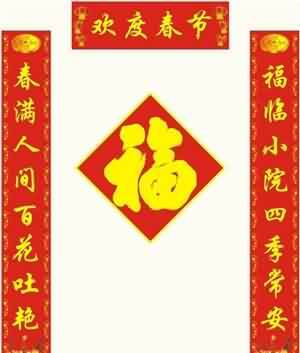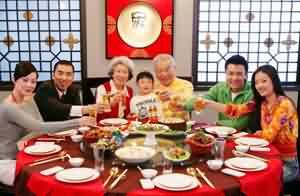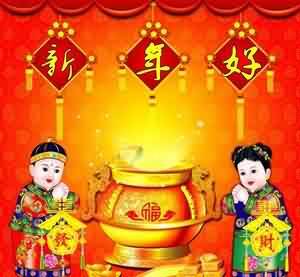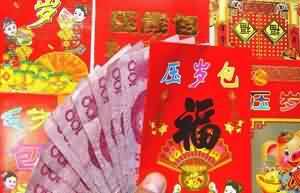 A red
A red  means good luck and fortune, so it is customary to post
means good luck and fortune, so it is customary to post on doors or walls on auspicious occasions such as wedding, festivals.
on doors or walls on auspicious occasions such as wedding, festivals.
[attach]21013[/attach]
Chinese New Year Celebration is the most important celebration of the year. Chinese people may celebrate the Chinese New Year in slightly different ways but their wishes are almost the same; they want their family members and friends to be healthy and lucky during next year.
Chinese New Year Celebration usually lasts for 15 days. Celebratory activities include Chinese New Feast, firecrackers, giving lucky money to children, the New Year bell ringing and Chinese New Year Greetings. Most of Chinese people will stop the celebrating in their home on the 7th day of New Year because the national holiday usually ends around that day, however celebrations in public areas can last until the 15th day of New Year.
2017 is the year of the Rooster in the Chinese zodiac. Rooster years:...1921, 1933, 1945, 1957, 1969, 1981, 1993, 2005, 2017, 2029… If you were born in a year listed, then you are a Rooster.
To clean houses on the New Year Even is a very old custom dating back to thousands of years ago. The dust is traditionally associated with “old” so cleaning their houses and sweeping the dust mean to bid farewell to the “old” and usher in the “new”. Days before the New Year, Chinese families clean their houses, sweeping the floor, washing daily things, cleaning the spider webs and dredging the ditches. People do all these things happily in the hope of a good coming year.
One of the house decorations is to post couplets on doors. On the Spring Festival couplets, good wishes are expressed. New Year couplets are usually posted in pairs as even numbers are associated with good luck and auspiciousness in Chinese culture.
People in north China are used to posting paper-cut on their windows. When sticking the window decoration paper-cuts, people paste on the door large red Chinese character  A red
A red  means good luck and fortune, so it is customary to post
means good luck and fortune, so it is customary to post on doors or walls on auspicious occasions such as wedding, festivals.
on doors or walls on auspicious occasions such as wedding, festivals.

The couplets of the Spring Festival are couplets hung on the columns of a hall in the Spring Festival’s Eve. It is called “Chun Lian” (春联) in Chinese. Being a unique literary form to China, the Couplets of the Spring Festival mostly describe the bustling atmosphere during the Spring Festival and express Chinese people’s hopes for prosperity in the New Year.
The origin of the couplets of the Spring Festival is “Tao Fu” (peach wood charms against evil). The history of Tao Fu can be traced back to more than 3000 years ago. At that time, people wrote the names of two gods who can control evil spirits on two pieces of peach wood. And Tao Fu evolved into today’s couplets in Spring Festival in Song Dynasty (960 A.D. — 1279 A.D.), and the peach wood was gradually replaced by two piece of paper.
Except that the couplets of the Spring Festival in Buddhist temples are written on yellow paper, the couplets are usually written on red paper because red is the color of peach wood, and the color of red can bring good luck and defeat evil spirits. However, when there is a death in the family, the younger generation of the deceased cannot use red paper to write couplets of Spring Festival for three years in a row. They use white paper in the first year, green paper in the second year and yellow paper in the last year. In some places, the younger generation even cannot use couplets during Spring Festival for three year to show their respect for the deceased.
Mostly, the couplets of Spring Festival are glued to the front door frame. Sometimes, families also paste couplets on the doors of pigpen, kennel, pheasantry and so on, hoping that the domestic animals are all thriving and healthy. Some families even paste couplets on both sides of the picture or statue of a god or the Buddha, hoping that the god or Buddha can bless the whole family and give them a smooth and prosperous year.
Generally, The Spring Couplet is composed of two antithetical sentences on both sides of the door. The couplets are read from top to bottom and the first line starts from the right. Apart from the two lines, some couplets even have a horizontal scroll bearing an inscription, usually an auspicious phrase, above the gate. It is read from right to left.

Spring Festival is a time for family reunion. The New Year's Feast is "a must" banquet with all the family members getting together. The food eaten on the New Year Even banquet varies according to regions. In south China, It is customary to eat "niangao" (New Year cake made of glutinous rice flour) because as a homophone, niangao means "higher and higher every year". In the north, a traditional dish for the feast is "Jiaozi" or dumplings shaped like a crescent moon.
The dinner on New Year’s Evening is also known as a family reunion dinner. It is one of the most important events in the New Year’s Evening. It reflects how Chinese society values the importance of family. The dinner on New Year’s Evening give all the family members a chance to get together and enjoy the happiness of a family union.
When children are out playing and shooting off firecrackers, the housewives are busy in the kitchen, preparing for the family reunion dinner. What’s more, the dumplings to eat on the first day of the New Year should also be made in this evening.
The dinner on New Year’s Evening should be very sumptuous and traditionally include fish. This is because fish in Chinese pronounced as “Yu” (鱼), same with the pronunciation of the Chinese character “余” in the phrase of “年年有余” (meaning may you always get more than you wish for every year). So fish symbolizes surplus or success in Chinese culture.
From the cultural meaning of fish, we can see that the food items chosen in the dinner on New Year’s Evening are quite recherché and dainty. Usually, a typical family reunion dinner on New Year’s Evening includes the following food items:
Dumplings (Jiao Zi): In the northern part of China, dumplings are essential to the dinner on New Year’s Evening, because the shape of a dumpling resembles an ancient Chinese gold ingot. Usually the housewives like to put a coin in on dumpling when making the dumplings, and the one who by chance to eat this specific dumpling is believed to have a lucky and prosperous year.
New Year Cake (Nian Gao): The New Year Cake is also important to the dinner on New Year’s Evening, because the pronunciations of it is a homophone for “年高” (meaning a more prosperous year). It is mostly made of sticky rice and sugar, and some other ingredients according to personal tastes.
Noodles: Many families eat noodles on New Year’s Evening because noodles represent longevity and long life. However, this practice is not limited to the dinner on New Year’s Evening.
Chicken: The importance of chicken is the same with that of fish. The pronunciation of chicken in Chinese (Ji) is a homophone for “吉” meaning good luck.
Traditionally, most of the dishes in the dinner of New Year’s Evening are not healthy, with high fat and high heat. However, with the upturn of Chinese people’s living standards, the dinner of the New Year’s Evening is becoming healthier and healthier, and more and more vegetables are appearing in this significant dinner.
The first bell ringing is the symbol of Chinese New Year. Chinese people like to go to a large squares where there are huge bells are set up on New Year’s Eve. As the New Year approaches they count down and celebrate together. The people believe that the ringing of huge bell can drive all the bad luck away and bring the fortune to them. In recent years, some people have begun going to mountain temples to wait for the first ringing. Hanshan Temple in Suzhou , is very famous temple for its first ringing of the bell to herald Chinese New Year. Many foreigners now go to Hanshan Temple to celebrate Chinese New Year.
Shousui means to stay up late or all night on New Year's Eve. After the great dinner, families sit together and chat happily to wait for the New Year’s arrival.
Lighting Firecrackers used to be one of the most important customs in the Spring Festival celebration. However, concerning the danger and the negative noises that lighting firecrackers may bring, the government has banned this practice in many major cities. But people in small towns and rural areas still hold to this traditional celebration. Right as the clock strike 12 o'clock midnight of New Year's Eve, cities and towns are lit up with the glitter from fireworks, and the sound can be deafening. Families stay up for this joyful moment and kids with firecrackers in one hand and a lighter in another cheerfully light their happiness in this especial occasion, even though they plug their ears.

On the first day of the New Year or shortly thereafter, everybody wears new clothes and greets relatives and friends with bows and Gongxi (congratulations), wishing each other good luck, happiness during the new year. In Chinese villages, some villagers may have hundreds of relatives so they have to spend more than two weeks visiting their relatives.
On the first day of the new year, it’s customary for the younger generations to visit the elders, wishing them healthy and longevity.
Because visiting relatives and friends takes a lot of time, now, some busy people will send New Year cards to express their good wishes rather than pay a visit personally.

It is the money given to kids from their parents and grandparents as New Year gift. The money is believed to bring good luck, ward off monsters; hence the name "lucky money". Parents and grandparents first put money in small, especially-made red envelopes and give the red envelopes to their kids after the New Year's Feast or when they come to visit them on the New Year. They choose to put the money in red envelopes because Chinese people think red is a lucky color. They want to give their children both lucky money and lucky color.
The customs about giving out red envelops (or red packets) are different in mainland China and in Hong Kong.
In mainland China, a Red envelopes or a red packet is a monetary gift which is passed out during the celebration of Chinese New Year. Usually, it is given from married couples or elderly generations to unmarried younger generations. The color of red symbolizes vitality, happiness and good luck in Chinese culture. Giving red envelopes to unmarried younger generation means giving best wishes and good luck to them. The money inside the red envelope is only used to make children happy; however, the importance of the red envelope lies in the red color which is loaded with cultural meaning. So, it is impolite to open the red envelope before the elderly generations who gives it to you.
The red envelope passed out during the Chinese New Year is commonly referred to as Ya Sui Qian (压岁钱) in Chinese, which is evolved from “压祟钱”. “祟” means evil spirits in Chinese, which can do harm to children during the Chinese New Year. And “压” means prevent or subdue in Chinese. So, if parents want the children to have a lucky new year, they need something to prevent the evil spirits from harming the children. By chance, a couple in ancient times found out that copper cash in red envelopes can scared the evil spirits away. So, more and more families used red envelopes with copper cash to protect their children. And with years of evolution, today’s red envelopes gradually came into being.
There are two kinds of red envelopes in mainland China. The first kind cannot even be called red envelope because there’s no envelope at all. Parents use colorful ropes to tie some copper cash together, and weave it in the shape of a dragon. Then they put it at the foot of the bed to scare evil spirits away. Another kind is the commonly seen red envelope: parents or other elder generations put money in red envelopes, and give the red envelopes to the children in front of everybody or put the red envelope under the pillow of the children in the Spring Festival’s Eve.
The amount of money inside the red envelopes varies from a couple of RMB yuan to several hundreds of RMB yuan. Little children usually use the money to buy firecrackers, candies, toys and so on. And students usually use the money to buy books and school supplies.
Some cities in mainland China have their unique customs. For example, in Fushun City, Liaoning Province, people have to give younger generations red envelopes immediately the year they find a job. In Weifang City, Shandong Province, young people over 18 years old, even thought they are still unmarried, cannot take red envelopes any more. In Shanghai, children don’t need to wait till the first day of the New Year to get the red envelope; they can get it on Spring Festival’s Eve. However, in some cities of Guangdong Province, children have to wait till the Lantern Festival to get their red envelopes.
The custom to giving out red envelopes in Hong Kong is quite different from that in mainland China. Apart from unmarried younger generation, Hong Kong people also give red envelopes to children in the neighborhood and unmarried colleague and friends even they are much older. Sometimes, they even give red envelops to they boss if the boss is still unmarried. Some people even give red envelopes to workers in their housing estate. The amount of money inside the red envelope is mostly 10 HK dollars to 20 HK dollars, seldom more than 50 HK dollars. When giving out red envelops, Hong Kong people always keep mumbling some words like May you be happy and prosperous or enjoy good health etc. Hong Kong people are not only fond of giving out red envelops, but also fond of accepting red envelopes. Some Hong Kong people even come all the way to ask people for red envelops. This is because Hong Kong people believe that red envelopes can bring good luck and great fortune, and can give people a smooth and prosperous year. The custom of red envelops in Guangzhou is similar to that of Hong Kong.
| 欢迎光临 英语听力论坛 (http://bbs.tingroom.com/) | Powered by Discuz! 7.2 |